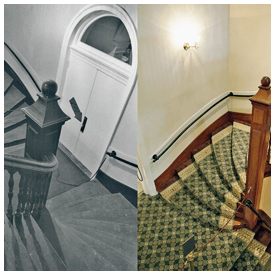Broken Lightner
by Angela deGregory
Special to Historic City News
When the Alcazar Hotel opened in 1888, it became a more distinguished hotel than was expected. Henry Morrison Flagler wrote at the time that the Alcazar Hotel was “every bit as great” as the Ponce De Leon.
In the 19th century, a Casino was not considered a gambling facility but was more of a recreational facility; where guests could enjoy the spa, gymnasium and swimming pool, among other activities. The Casino at the Alcazar quickly became the most popular hotel complex in the area for people to gather.
In the evenings people would convene in the Grand Ballroom where there were performers and live music regularly. It was so trendy that after a few seasons, more guest rooms had to be added.
The Lightner Museum is now housed inside of the historic Alcazar Hotel. Like any 130-year-old structure, it too requires a significant amount of maintenance. Otto Lightner’s diverse and eclectic collection demands a high amount of attention as well. When Lightner Museum Curator Barry Myers created March’s Curator’s tour, “Broken Lightner”, the point was to educate people on the struggles of maintaining the museum.
Upon researching the Alcazar Hotel Casino further, The Grand Ballroom was described as “profound, elegant, and grand, with its highly polished wood floors”. It was the perfect space for extravagant parties, which Henry Flagler hosted frequently.
The Ballroom Gallery is now a vast and illustrious space, in which the Lightner Museum takes great pride. However, after the Alcazar Hotel closed in 1931 the Ballroom deteriorated quickly. The space was used for storage for a number of years. A hole was cut into the ceiling where a rickety staircase was installed to allow access to the 4th floor.
The restoration of the Ballroom was complete in 1997. Director Robert Harper raised more than $500,000 to put towards the restoration. The State of Florida provided the Lightner with a grant, making the restoration a $1,200,000 project.
“The Ballroom wasted away as unused storage space for more than half a century. Not only does it showcase some of the museum’s most significant holdings, but due to its immense size and grandeur it has served as a gathering space for large community events.” -Director Robert Harper
The Lightner Museum was given awards by The Florida Trust for Historic Preservation, and the Jacksonville Chapter of The American Institute of Architects for the impressive restoration of the Grand Ballroom.
Although the Grand Ballroom has been restored, the museum wants to continue to improve the space. Lightner Museum Curator Barry Myers hopes to have plasterwork repaired that has been damaged by leaks prior to the new roof. There are plans to repaint this coming year. The museum will be having all the windows in the Ballroom Gallery tinted to block UV light, helping to preserve some of the newly restored items that will be displayed in the space.
The newly restored items that will be displayed in the Ballroom Gallery were restored through the Lightner Museum Adopt an Artifact program. Adopt an Artifact allows people to donate money to the museum that goes directly towards the restoration of items in the collection.
The Lightner is pleased to share that Winged Mercury has been adopted and will be restored this year. The museum is currently researching to find the best possible restoration professional for the job, and we cannot wait to see Mercury in all his glory. Mr. James Ridley donated the $5,000 needed for Mercury’s restoration.
Parts of the Lightner Museum will always be broken over time, but with community support we can continue to make it shine for generations to come.
The Lightner Museum is a non-profit cultural institution sustained by generous support of individuals, businesses and sponsors.
Discover more from HISTORIC CITY NEWS
Subscribe to get the latest posts sent to your email.







